Abstract
A computer simulation of atoms and molecules moving physically is called molecular dynamics or MD. The numerical solution of the classical equation of motion step-by-step makes up molecular dynamics. The goal of molecular dynamics is to improve the current drug discovery process. We provide a general overview of the tools, force-field, stages, applications, limitations, and future prospects of molecular dynamics in this paper. Molecular dynamics is performed using tools such as GROMACS, AMBER, CHARMM-GUI, NAMD, and LAMMPS. The term force-field refers to the variety of interatomic potentials that we discuss here. More specifically, the functional form and parameter sets needed to determine a system's potential energy at the atomistic level are referred to as the force-field. In this review, we provide details on the steps that are crucial for doing molecular dynamics. MD can be used for docking, protein folding, membrane proteins, structure refinement, predicting molecular flexibility, examining how stimulation influences interaction, and biomedical applications.
Keywords
Molecular dynamics, drug development, tools, steps.
Introduction
For the past twenty years, drug discovery has made use of computer-aided drug design techniques. A strict understanding of the receptor-ligand interaction process was the foundation of molecular modeling, docking, and simulation techniques with the use of computing resources. The goal of the molecular docking technique is to comprehend the interactions between two or more molecular structures. A protein's alignment and binding capacity at the active site of a target protein are mostly predicted by peptide–ligand (tiny component), peptide–nucleic acids, as well as peptide–protein docking. MD is a thermodynamic-based technique that is frequently used to comprehend the receptor-ligand interaction complex, also known as the docked complex, by atomic conformational detail. This approach is helpful for characterizing conformational changes and examining the energy landscape of protein-ligand interactions, which are typically not accessible through high-resolution experiments. Rescoring of the docked complex is made possible by the structural improvements of post docking complexes, which pinpoint the complementarity between receptor-ligand complexes and improve the complex state. Protein-ligand, protein-nucleic acid, and protein-peptide binding are examples of bimolecular processes that could be studied using MD modeling. These processes conformational changes can show where the all-atomic resolution is oriented at femtoseconds (fs). The simulations may reveal the presence of biological disorders.(1) Dynamic simulation techniques are commonly utilized to obtain kinetic and thermodynamic information as well as information on the time evolution of protein and other biological macromolecule conformations. It is possible to give the model for individual particle motions in high detail simply by using different equation. Simulation is a valuable tool for improving our understanding of model systems because it can be used to measure a system's properties precisely over a duration that is not available otherwise.(2) These days, the pharmaceutical industries rely on the structure-activity relationship and molecular modelling for drug development; two critical methods that enable effective, economical, and time-saving computer-aided drug discovery are molecular docking and molecular behaviour model. This field is expanding rapidly due to the abundance of structural information being produced for biological macromolecules, including several possible therapeutic targets, by developments in the structure of life techniques like high-throughput protein purification, nuclear magnetic resonance (NMR) spectroscopy, X-ray crystallography, and others. More than 140,000 three-dimensional molecular structures of different biomolecules, including a number of proteins and protein-ligand complexes, are currently available in the PDB database.(3) These efforts to improve docking procedures have benefited greatly from the application of chemical dynamics (MD) model. (4)
Purpose of Molecular Dynamic:
- For many a long time, this application of molecular dynamics modelling (MD) in drug development has established a paradigm. The timely and linked prediction of atom movement in a system with molecules is often aided by simulation, which uses physics-dependent intermolecular interaction.In a bimolecular system, recording the position and mobility of each atom provides valuable information. In the shortest amount of time, the intricacy surrounding the wet assays is reduced because this difficult task in the wet lab is easily simulated.(5,6)
- The conundrum surrounding the disorders connected to folding errors & clumping of proteins may also be answered by molecular dynamics simulation, which could lead to the development of small molecular modulators.(7, 8)
- There has been evidence recently of the application of MD simulation to target drugs used to treat or manage neurological diseases.(9)
- Using molecular targets, particularly proteins, a large library of ligands is screened in the context of the structure-based drug discovery technique to select hit compounds for docking assays.These targets are the result of experimental work in NMR, homology modeling, X-ray crystallography, and other fields. They are sourced from sources such as the Protein Databank and Alpha-Fold protein structure database. (10,11)
Tools for Molecular Dynamic:
There are five tools for molecular dynamic as following;-
- GROMACS
- AMBER
- CHARMM-GUI
- NAMD
- LAMMPS
- GROMACS:
A popular program for bimolecular simulation, GROMACS has developed over the past 20 years from small-scale efficiency to multi-level parallelism and advanced heterogeneous acceleration, aiming for some of the world's biggest supercomputers.(12) Molecular dynamics (MD) program useful for bio(macro)molecules in an aqueous environment; it can be utilized on any conjunction method over and that a set of processing companies is possible to map and it supports PVM-like prevent communication and reception calls. The purpose for which it was created was to facilitate communication between both the right and left neighbours of the 32-system ring GROMACS (GROningen MAchine for Chemical Simulation). Preprocessor, parallel MD and energy minimization program, optional monitor, and many analytic tools make up the GROMACS software. The program can be start form any number of processors, including one. The ANSI C applications can be accessed via file transfer protocol. (13)
- AMBER:
For doing MD simulations, AMBER (Assisted Model Building with Energy Refinement) is a popular software program that has been under development for a long time. Sander (Simulated Annealing with NMR-Derived Energy Restraints) & Premed are the primary software packages used in AMBER for MD simulation. AMBER premed module offers a more effective way to implement some of the capabilities found in sander, with a primary focus on GPU (Graphic processing unit) acceleration and improved parallel scaling.(14) There are many software programs available for performing MD simulations; The most recent edition is the result of over 33 years of work, starting with the initial version in 1979, and six years of continuous development by several research groups since version 9. Version 12, the most recent edition of the AMBER package, was made available in April 2012 and contains a significant number of significant advancements in the fields of computer science and science.(15)
- CHRMM-GUI:
CHARMM-GUI (Chemistry at HARvard Macromolecular Mechanics Graphical User Interface), one of many web-based modeling tools, aims to make common and advanced simulation techniques easier to use by streamlining and generalizing the protocols for creating intricate simulation systems and preparing simulation input files for popular simulation packages like CHARMM, NAMD, GROMACS, AMBER, GENESIS, LAMMPS, Desmond, Open MM, and CHARMM/Open MM. Complex modeling software is frequently required to comprehend and construct complex simulations systems, which are sometimes made up of several components. The CHARMMGUI Membrane Builder is a tool that effectively combines complex processes into a streamlined workflow. Depending on the system size, it can produce a membrane-only system or a realistic protein-membrane complex in a matter of minutes to many hours. Motivated by a task-oriented design approach. CHARMM-GUI's development philosophy focuses on providing a simplified interface to assist users in completing tasks, such as solving a protein or building a membrane system, rather than supplying the technical details of molecular modeling. This design philosophy aids in our team's critical analysis of the workflow throughout interface design, making CHARMM-GUI both user-friendly and valuable for professionals in modeling tool usage, particularly for batch system production. With any design choice, the task-oriented strategy used in CHARMM-GUI comes with tradeoffs. (16)
- NAMD:
NAMD (Nanoscale Molecular Dynamics) is a parallel molecular dynamics algorithm that can be used to simulate large biomolecular systems with high efficiency. NAMD runs not just on single desktop and laptop computers but also scales to hundreds of processors on pricey commodity clusters and tens of processing on advanced concurrent systems. NAMD supports the formats of files, the variables, and potential applications for CHARMM and AMBER. (17) The scalable MD program NAMD can simulate all-atom systems made up of millions of atoms in proteins and DNA under both stable and fluctuating settings. NAMD maintains the typical limitations of all-atom MD, including extremely brief simulation durations, and is dependent on AMBER and CHARMM settings. When examining interactions between DNA nanostructures and membranes or integrated functional components like proteins and other organic molecules, NAMD is more effective than a coarse-grained model. Additionally, NAMD provides steered and interactive molecular dynamics (SMD, IMD) to facilitate passage across high energy barriers of the nanostructure's conformational environment.(18)
E) LAMMPS:
Nowadays, LAMMPS (Large-scale Atomic/Molecular Massively Parallel Simulator) is the most popular open-source molecular dynamics simulation software because of its many features, good adaptability, and active community support. However, the incompatibility of the input and output file formats is impeding the ability to transfer GROMACS simulations to LAMMPS. (19) The classical molecular dynamics simulator LAMMPS has gained popularity as a tool for particle-based material modeling at length scales spanning from atomic to mesoscale and continuous since it was made available as open source code in 2004. Its appeal stems from the fact that it offers an extensive range of particle interaction models that operate on any platform using a single CPU core for various materials to the biggest accelerator-equipped supercomputers, and that it allows users to customize the specifics of the simulation, through the input script or by including new code for constraints, diagnostics, and new interatomic potentials, any additional elements required for their models. Modeling materials at length scales ranging from atomic to mesoscale and continuous using particles has become a common practice with the release of the classical molecular dynamics simulator LAMMPS as open source code in 2004. Its ability to run on any platform, from a single CPU core to the largest supercomputers with accelerators, and the sheer variety of particle interaction models it offers for various materials, coupled with the fact that users can add code for new interatomic potentials, constraints, diagnostics, or other features required for their models, or modify the input script, are some of the reasons for its widespread popularity. Consequently, hundreds of people have added new features to LAMMPS, which now includes a million lines of code instead of the 50,000 lines it had in 2004.20)
Force fields:
An empirical collection of energy functions that aids in our comprehension of the energy involved in atomic contact is what is known as the force field.(21) A force field is usually the product of covalent and non-covalent interactions between atoms and molecules, or of bound and non-bonded terms, such as
ETotal = EStretch+ EBend+ ETorsion+ EElectrostatic+ Evan der Waals+ EHydrogen Bond
Let's now quickly review the definitions of these terms:
Bond Stretching (EStretch) - It explains the bond length's energy of deformation in relation to its equilibrium value. Harmonic potential, which forbids bond disruption, can be used to estimate the energy near-equilibrium. Vibration spectroscopy can be used to determine the stretching force constant.
Angle Bending (EBend) - This force constant can be found by vibration spectroscopic research. It describes the deformation energy of the bond angles with respect to their equilibrium value. The energy near-equilibrium can be approximated by applying harmonic potential.
Torsional Term (ETorsion) - It is space-based and explains the rotation of covalent bonds. There are several geometric functions that can be used to approximate this word.
Electrostatic Term (EElectrostatic) - Coulomb's Law is utilized in the calculation, incorporating partial charges determined by Quantum Mechanics. Static partial charges and polarisable charges can also be included in calculations based on individual demands for more accurate results.
Van der Waals Term (EVan der Waals) - In layman's words, it describes the interatomic forces, which are the mutually attractive and repulsive interactions between atoms. A function of the separation between the centres of the two interacting atoms or molecules, the Lennard Jones 12-6 potential can be used to approximate this phrase.
Hydrogen Bond Term (EHydrogen Bond) - The energy that exists between atoms that could result in hydrogen bonds is described. Although the attractive connection between atoms vanishes more quickly in this scenario, it can be approximated using the 12-6 potential, which is comparable to the Lennard Jones Potential.
Cross Terms - The majority of the interaction terms we just looked at typically influence one another rather than existing alone in biomolecules. All such interactions involving other people are accounted for by cross term. Stretch-stretch, stretch-bend, bend-bend, bend-torsion, and stretch-torsion types of interactions are examples of cross terms. (22)
Step in Molecular Dynamics:
MD Three primary steps are used to complete a simulation, each of which has minor steps.
- Model Selection
- Energy Minimization. Heating and Equilibration
- Production Run and Analysis
When discussing Chimera, it is helpful to consider Molecular Dynamics Simulation as a connection to the molecular dynamics and minimization algorithms offered by the Molecular Mechanics Toolkit (MMTK), which is integrated with the program. While non-standard residues are given parameters using Chimera's Antechamber module, standard residues are given Amber parameters.
- Model Selection:
It is necessary to select a model system of interest. While entire models are usually usable, in the event that they are not, the missing segments are secured and the protonation states conditioned. This stage should take into account and incorporate all atoms of interest, as models that are not included here will be disregarded. The produced molecule needs to be read from the PSF and PDBF files.
Obtaining Files- Typically, simulations begin with a typical PDB file with a crystal structure obtained from the Protein Data Bank. We are interested in the following details about the atoms: names (N, C, and CA), occupation, coordinates, residue name and ID, beta factor (also known as temperature factor), and segment ID.
ii) Energy Minimization: Heating and Equilibration: In this stage, Newton's equations of motion are solved in order to equilibrate the observable structure with the force field (T=0). Additionally, we choose the amount of equilibration stages (5000 by default). The system is then heated by rescaling the velocities while maintaining system stability until the system achieves a specific temperature and its attributes stop changing over time.
Preparing the System for Energy Minimization- Force field computations are used to determine the energy of the system. The method of minimizing involves changing the system's conformation in order to find lower energy conformations. Various minimization techniques are available, such as
- steepest descent (slowly converging – used for highly restrained systems)
- conjugate gradient (efficient, uses intelligent choices of search direction – used for large systems)
- Broyden-Fletcher-Goldfarb-Shanno (BFGS) (quasi-newton variable metric method)
- Newton-Raphson (calculates both slopes of energy and rate of change)
When adding a solvent box, periodic boundary conditions ought to be applied. When utilizing periodic boundary conditions, the cut-off distance must not be greater than half of the smallest box dimension. When performing computations, Fixed Atoms can help determine whether certain atoms need to be frozen in place. Such "frozen" atoms are indicated by selection; however, one must always keep in mind that all atoms in the target model-fixed or not-will be included in the energy calculations. During MD, Translation Remover helps to subtract out a global translational motion and selects which steps, by default the first, third, fifth, etc., to proceed with. In addition to assisting in the subtraction of a global rotating motion during MD, the Rotation Remover selects which steps-by default, the first, third, fifth, etc. to proceed with files related to topology: To distinguish between various elements and molecular orbital settings, the atom types are assigned in them. Additionally, linkage between the atoms is built and charges are assigned to each one. In addition to the recommended parameters for configuring the energy calculations, parameter files provide the force constants needed to characterize the bond energy, non-bonded interactions (van der waals and electrostatic), angle energy, torsion energy, etc.
Since most biological processes take place in aqueous solutions and because solvation effects are crucial in determining molecule conformation, electronic characteristics, binding energies, and other details, it is imperative to do a thorough solvation step. Explicit treatment and implicit treatment are the two ways that models can be solved. Solvent molecules are introduced to the molecular system during explicit treatment, while the solvent is modelled as a continuum dielectric during implicit treatment.
iii) Production Run and Analysis:
Next, the model is simulated using NVT, NPT, and other desired circumstances. In order to obtain the output trajectories, a production run is ultimately carried out for a certain amount of time. The "include production phase" option aids in determining if and how many steps to include in a phase if the production MD is to be included. It's also important to note the time steps at which we write the trajectory files, which are then examined in more detail to extract the relevant features. We are now able to perform the simulation process on a time scale of seconds to microseconds and even milliseconds because to the steady development potential computer sampling methods. It is important to highlight that because coordinates in computer simulation are created at the femtosecond level, these millisecond scales in simulation are thought to be quite vast and contradict the in vitro experiment. Transitioning from the femtosecond to the millisecond scale provides a vast array of conformations that may unlock numerous biological riddles. (23)
Application of molecular dynamics:
- Refining structure predictions:
Structure prediction is one of the earliest subjects to be studied in structural bioinformatics. Ab initio protein structure prediction has been a common application of MD, including the longest-running simulations to date. Modelling protein folding in an attempt to develop a mathematical description for proteins structure, even if this is not the best course of action. Template-based modelling is, instead, the most efficient technique. (24,25) One or more 3D protein structures that have a fair resemblance to the target protein are used as templates in template-based modeling. The final product is a model with the new amino acid sequence and a structure that averages the templates that were utilized, regardless of the modeling algorithm. Typically, the final stage of the prediction process entails applying standard molecular mechanics to relax the structure. In others, the entire procedure is carried out using restricted simulations. (25) It would seem sense to refine such models by using MD simulations. (26)
- Protein folding :
MD is an invaluable technique when studying thermodynamics and protein structure and stability in silico. Ab initio folding simulations with explicit water are restricted to peptides and extremely small proteins due to computing cost, whereas simulations of real-size Absorptive folding simulations can be performed in real time by using mesoscopic models with physics-based potentials (e.g., UNRES), which represent a reasonable compromise between processing cost and accuracy. Compared to rigid-body, dihedral-angle, or collective coordinates, which offer less speed-up, this method seems to be preferred. Protein folding analysis needs to be done in terms of the time evolution of ensembles rather than of a single molecule, necessitating the execution of several simulations in order to identify every potential folding pathway. This is currently limited to mesoscopic models. Additionally, tracking the advancement of folding requires the usage of multiple observables. Given their ease of parallelization, multiple-trajectory simulations may fully benefit from distributed computingExchange of replicas One MD extension that boosts simulation size and duration without sacrificing fine-grained folding route information is MD.(27)
- Applications of Molecular dynamic in Membrane Proteins:
Membrane protein analysis, including membrane protein permeability, protein–ligand interactions, lipid protein interaction, and protein structure and dynamics, has seen a rise in the use of molecular docking (MD). [28&29] In order to answer issues regarding protein structure, MD is also utilized in conjunction with a broad range of experimental methods, such as X-ray, crystallography, nuclear magnetic resonance (NMR), electron paramagnetic resonance (EPR), cryo-electron microscopy (cryoEM), and Foster resonance energy transfer. (30)
- Flexibility of Molecules:
Biomolecules' flexibility actively influences cellular function by directly influencing how they associate with nearby atoms, molecules, and ions. As we have already seen, molecular dynamic system may be viewed as a partial reflection of a system's flexibility and offers useful information about the constant change of any system. A number of methods that can be utilized to estimate the main contributing movements of the system under study have recently been developed. These include the Anisotropic Network Model (ANM), Elastic Network Model (ENM), and Principal Component Analysis (PCA), among a few others. (31)
- Provides a Temporal Scale View of Molecular Interactions:
Molecular dynamics simulation creates images of the atomic-level intricacies of the biomolecular system's dynamic evolution.This characteristic, when combined with the temporal scale for MD simulations, allows us to forecast various potential cellular interactions and behaviors depending on what changes in the current structures can be made and observed. This is very useful when examining the characteristics of these samples that may eventually be used as powerful pharmaceuticals. (32)
- Docking:
Docking is the process by which a number of molecules arrange themselves to bind to one another to form a stable complex. Protein-ligand, protein-protein, DNA-protein, and DNA-ligand interactions are all commonly studied using MD simulation. Examining the impact of novel molecular interactions generally excites researchers. For this reason, in order to determine the impact of contacts on a time scale, docking is carried out initially, followed by MD simulation. Several methods are used by docking software, such as Glide, GOLD, AutoDock, etc., to determine a docking score based on various factors including surface of contact, electrostatics, etc. (33)
- To understand how Mutation affects Interactions:
A specific amino acid's effects on binding with its counterpart are better understood by changing the residue and carefully examining the variations in the simulated trajectories before and after the process. To increase the ligand's affinity and gain a better understanding of its structural and interaction characteristics, adjustments and modifications can also be made to the ligand. (34)
- Biomedical :
Molecular dynamics (MD) modelling is widely used in the biomedical field to examine conformational shifts in proteins caused by mutations or by the binding and unbinding of ligands. It offers several viewpoints that are hard to get across in conventional biochemical or pathological investigations, such as the in-depth impacts of mutations on the atomic-level interactions between proteins and ligands and the structure of proteins. A general review of conformational changes and MD simulation-based drug development is provided in this study. We first discuss the preparation of the amino acid framework for the model of MD, which is an important step that determines the accuracy of the simulation. We then give a summary of the typical applications of force fields and MD simulations in science. Ultimately, improved sampling techniques and typical uses for these techniques are presented. To sum up, MD modeling is an effective tool that can direct experimental research. A thorough grasp of the connection between protein structure and function can be gained by combining MD simulation with experimental methods to solve biological issues beforehand. (35)
- Understanding in Terms of Atomic Properties:-
The ability of computer simulation to investigate molecular events at the level of the atom is among its most obvious applications. Biochemical Data Interpretation on Repressor-Operator Binding by MD Digital Simulator MD's interpretation of biophysical data regarding the properties of membranes Digital Emulation.
- Determination of Spatial Molecular Structure on the Basis of 2D-NMR, X-Ray or Neutron Diffraction Data:-
In the past few years, computer modeling has established itself as a common technique for determining the spatial molecular structure of compounds based on 2D-NMR, X-ray, or neutron diffraction data. The goal of establishing a structure using experimental NMR or diffraction data is to identify a molecular structure. The refinement of structures can be based on NMR data, X-ray, neutron diffraction, or crystallographic data.
- Prediction of Structural Changes by MD Simulation:
This use case demonstrates the effectiveness of MD simulation in examining the structural characteristics of flexible molecules or mutants. However, the timeframe of an MD simulation (usually 10^39;-l02 ps) may be insufficient to bring about substantial conformational changes when they are expected, given the limited time available to overcome potential energy barriers.
- Prediction of Free Energy Changes by MD Simulation (36)
Limitation of molecular dynamics:
For the most part, liquid crystal nucleation is too rare to be accessible in the limited time scales of a conventional molecular dynamics (MD) simulation. Here, we developed a "persistent embryo" method to aid in crystallization generation in MD simulations by applying external spring forces to prevent microscopic crystal embryos from melting. Using this technique, we were able to achieve a nucleation rate that was in good agreement with the experimental results for the pure Ni instance at a moderate under cooling, where nucleation is not visible in the traditional MD simulation. Furthermore, the technique is used to model an even slower process: the B2 phase nucleation in a potent Cu-Zr alloy that forms glass. (37) For classical modeling of all-atom systems, MD has advanced to a mature stage in the nanoscale period range, but its reliability on larger periods remains in its early stages.(38) MD There are still problems that need to be resolved, such as the absence of representation standards, the inadequate analytical tools, and even the challenges associated with merely storing and sending the massive volume of trajectory data that is produced.(39)
Future scope MD:
Nowadays, molecular dynamics simulations are utilized to analyze almost all macromolecules of biological or therapeutic significance, including proteins, nucleic acids, and carbohydrates. Wide geographical, temporal, and resolution ranges are covered by simulations. Thousands to millions of individual atoms, which might represent all the atoms in a protein and the surrounding water molecules, move in discrete time steps that are short (like two femtoseconds) in explicit, all-atom MD. In order to update the atomic location and velocity, Newton's equations regarding movement are used to determine the forces acting on each atom at each step. The forces are derived from the "force field," a set of physics-based parameters that represent both bound and non-bonded (such as van der waals) inter-atomic forcesThis technique is repeated billions of times to create continuous atomic trajectories that can last up to 1μs. The following examples show some of the insights and current capabilities of MD simulations. Millions of atoms can make up the biological systems that are explored by all-atom MD simulations. For example, multiple such simulations of bacterial ribosome, the crucial RNA/protein complex targeted by various antibiotics, have been performed. Membrane proteins pose unique difficulties for experimental techniques, making MD simulations an ideal tool for studying them. For example, the regulation of ion channel conductance, also referred to as "gating," has been investigated for numerous channels, including the nicotinic acetylcholine receptor. Beckstein and Sansom determined the free-energy barrier to ion passage via the central pore of the nicotinic receptor using MD simulations and potential of mean force calculations. (40) The molecular dynamics (MD) method has extensive application in the fields of materials science, engineering, biology, physics, and theoretical chemistry. However, to computational costs, MD simulations can only be used to directly mimic dynamical processes over very short periods (e.g., nanoseconds or at most a few microseconds), though unstable processes can frequently require much longer timescales for simulation-especially when they involve thermal activation.(41)
CONCLUSION:
Molecular dynamics (MD) has become a potent computational method for examining the behavior of matter at the atomic level in previously unheard-of detail. Over time, MD has developed from its original goal of modeling the mobility of atoms and molecules to include advanced tools and algorithms that enable researchers to study ever-more complicated systems. The creation of easily accessible and adaptable MD software has simplified the typical workflow, which includes system setup, force field selection, simulation execution, and outcome analysis. These days, MD is used in many other sectors, including as materials science, medication development, energy storage, protein folding, and nanotechnology. Important insights into dynamic systems that are frequently unavailable through experimental approaches alone are provided by these simulations. Still, there are a number of problems that need to be resolved. Theoretical and technical advancements in various fields will likely make MD even more important in the future.
REFERENCES
- Singh S., Baker Q.B. and Singh D.B. “Molecular docking and molecular dynamics simulation.” In Bioinformatics 2008;291-304.
- Adcock S.A., McCammon J.A. “Molecular dynamics: survey of methods for simulating the activity of proteins.” Chem Rev. 2006 May;106(5):1589-615. doi: 10.1021/cr040426m. PMID: 16683746; PMCID: PMC2547409.
- Naqvi A.A., Mohammad T., Hasan G.M. and Hassan M.I. “Advancements in docking and molecular dynamics simulations towards ligand-receptor interactions and structure-function relationships.” Current topics in medicinal chemistry. 2018;18(20);1755-1768.
- Alonso H., Bliznyuk A.A. and Gready J.E. “Combining docking and molecular dynamic simulations in drug design.” Medicinal research reviews.2006; 26(5):531-568.
- Hollingsworth S.A., Dror R.O. “Molecular dynamics simulation for all.” Neuron 2018 Sep 19;99(6):1129–1143. https://doi.org/10.1016/j.neuron.2018.08.011. PMID: 30236283; PMCID: PMC6209097.
- Karplus M., McCammon J.A. “Molecular dynamics simulations of biomolecules.” Nat StructBiol 2002 Sep;9(9):646–52. https://doi.org/10.1038/nsb0902-646. Erratum in: Nat StructBiol 2002 Oct;9(10):788. PMID: 12198485.
- Ye W., Wang W., Jiang C., Yu Q., Chen H. “Molecular dynamics simulations of amyloid fibrils: an in silico approach.” ActaBiochimBiophys Sin 2013 Jun;45(6): 503–508. https://doi.org/10.1093/abbs/gmt026. Epub 2013 Mar 26. PMID: 23532062.
- Urbanc B., Betnel M., Cruz L., Bitan G., Teplow D.B. “Elucidation of amyloid beta- protein oligomerization mechanisms: discrete molecular dynamics study.” J Am ChemSoc 2010 Mar 31;132(12):4266–80. https://doi.org/10.1021/ja9096303. PMID: 20218566; PMCID: PMC5767167.
- Manglik A., et.al. “Structure-based discovery of opioid analgesics with reduced side effects.” Nature 2016 Sep 8;537 (7619):185–90.https://doi.org/10.1038/nature19112. Epub 2016 Aug 17. PMID: 27533032; PMCID: PMC5161585.
- Berman H.M., Westbrook J., Feng Z., Gilliland G., Bhat T.N., Weissig H., Shindyalov I.N., Bourne P.E. “The protein data bank.” Nucleic Acids Res. 2000 Jan 1;28(1):235–42.https://doi.org/10.1093/nar/28.1.235. PMID: 10592235; PMCID: PMC102472.
- Haddad Y., Adam V., Heger Z.. “Ten quick tips for homology modeling of high- resolution protein 3D structures.” PLoSComputBiol. 2020 Apr 2;16(4):e1007449.
- Pall S., Abraham, M.J. Kutzner, C., Hess B. and Lindahl E. “Tackling exascale software challenges in molecular dynamics simulations with GROMACS. In Solving Software Challenges for Exascale: International Conference on Exascale Applications and Software” 2015; EASC 2014, Stockholm, Sweden, April 2-3, 2014, Revised Selected Papers 2 (pp. 3-27).
- Berendsen H.J., van der Spoel D. and van Drunen R.. “GROMACS: A message-passing parallel molecular dynamics implementation.” Computer physics communications, 1995; 91(1-3):43-56.
- Kaus J.W., Pierce L.T., Walker R.C., McCammont J.A. “Improving the Efficiency of Free Energy Calculations in the Amber Molecular Dynamics Package.” J Chem Theory Comput. 2013 Sep 10;9(9):10.1021/ct400340s. doi: 10.1021/ct400340s. PMID: 24185531; PMCID: PMC3811123.
- Salomon?Ferrer R., Case D.A. and Walker R.C. “An overview of the Amber biomolecular simulation package.” Wiley Interdisciplinary Reviews: Computational Molecular Science. 2013;3(2):198-210.
- Jo S., Cheng X., Lee J., Kim S., Park S.J., Patel D.S., Beaven A.H., Lee K.I., Rui H., Park S. and Lee H.S. “CHARMM?GUI 10 years for biomolecular modeling and simulation.” Journal of computational chemistry.2017; 38(15):1114-1124.
- Phillips J.C., Braun R., Wang W., Gumbart J., Tajkhorshid E., Villa E., Chipot C., Skeel R.D., Kale L., Schulten K. “Scalable molecular dynamics with NAMD.” J Comput Chem. 2005 Dec;26(16):1781-802. doi: 10.1002/jcc.20289. PMID: 16222654; PMCID: PMC2486339.
- Tadija Kekic, Ivan Barisic. “In silico modelling of DNA nanostructures.” Computational and Structural Biotechnology Journal. 2020;18;1191-1201,ISSN 2001-0370.
- Chávez Thielemann H., Cardellini A., Fasano M., Bergamasco L., Alberghini M., Ciorra G., Chiavazzo E., Asinari P. “From GROMACS to LAMMPS: GRO2LAM: A converter for molecular dynamics software.” Journal of molecular modeling. 2019 Jun;25:1-2.
- Thompson Aidan P., et al. “LAMMPS-a flexible simulation tool for particle-based materials modeling at the atomic, meso, and continuum scales.” Computer Physics Communications. 2022;271: 108171.
- Mayo, S. L., Olafson, B. D., and Goddard, W. A. (1990) DREIDING: a generic force field for molecular simulations. Journal of Physical chemistry 94 (26), 8897-8909.
- Pearlman D. A., and Kollman P. A. “The overlooked bond?stretching contribution in free energy perturbation calculations.” The Journal of chemical physics. 1991;94 (6):4532-4545.
- Badar Mohammad & Shamsi Shazmeen & Ahmed Jawed & Alam, Afshar. “Molecular Dynamics Simulations: Concept, Methods, and Applications.” 2020;10.1007/978-3-030-94651-7_7.
- Dorn M., E Silva M.B., Buriol L.S., Lamb L.C. “Three-dimensional protein structure prediction: methods and computational strategies.” ComputBiol Chem. 2014;53:251–276.
- Bonneau R., Baker D. “Ab initio protein structure prediction: progress and prospects.” Ann Rev BiophysBiomolStruct. 2001;30: 173–189.
- Lance B.K., Deane C.M., Wood G.R. “Exploring the potential of template based modelling.” Bioinformatics. 2010;26(15):1849–1856.
- Sali A., Blundell T.L. “Comparative protein modeling by satisfaction of spatial restraints.” J Mol Biol. 1993;234(3):779–815.
- Raval A., Piana S., Eastwood M.P., Dror R.O., Shaw D.E. “Refinement of protein structure homology models via long, all-atom molecular dynamics simulations.” Proteins. 2012;80(8):2071–2079.
- Arcon J.P.; Defelipe L.A., Modenutti C.P., Lopez, E.D., AlvarezGarcia D.,Barril X., Turjanski A.G.,Marti M.A. “Molecular Dynamics in Mixed Solvents Reveals Protein-Ligand Interactions, Improves Docking, and Allows Accurate Binding Free Energy Predictions.” J Chem Inf Model 2017;57:846?863, doi:10.1021/acs.jcim.6b00678.
- Nair P.C., Miners J.O. “Molecular dynamics simulations: from structure function relationships to drug discovery.” In SilicoPharmacol 2014;2(4).doi:10.1186/s40203-014-0004-8.
- Fernandez?Leiro R., Scheres S.H. “Unravelling biological macromolecules with cryo?electron microscopy.” Nature 2016 ;537:339-346. doi:10.1038/nature19948.
- Bakan A., and Bahar I. “The intrinsic dynamics of enzymes plays a dominant role in determining the structural changes induced upon inhibitor binding.” Proceedings of the National Academy of Sciences. 2009;106 (34):14349-14354.
- Kroemer R. T. “Structure-based drug design: docking and scoring.” Current Protein and Peptide Science 2007;8 (4):312-328.
- Karaa W. B. A. “Biomedical image analysis and mining techniques for improved health outcomes” IGI Global.2015.
- Wu X., Xu L.Y., Li E.M., Dong G. “Application of molecular dynamics simulation in biomedicine.” Chem Biol Drug Des. 2022 May;99(5):789-800. doi: 10.1111/cbdd.14038. Epub 2022 Mar 17. PMID: 35293126.
- Van Gunsteren, W.F. and Berendsen H.J., “Computer simulation of molecular dynamics: methodology, applications, and perspectives in chemistry.” Angewandte Chemie International Edition in English.1990; 29(9):992-1023.
- Sun Y., Song H., Zhang F., Yang L., Ye Z., Mendelev M.I., Wang C.Z., Ho K.M. “Overcoming the Time Limitation in Molecular Dynamics Simulation of Crystal Nucleation: A Persistent-Embryo Approach.” Phys Rev Lett. 2018 Feb 23;120(8):085703. doi: 10.1103/PhysRevLett.120.085703. PMID: 29543013.
- Berendsen H.J.C. et.al. “Molecular Dynamics Simulations: The Limits and Beyond. In: Computational Molecular Dynamics: Challenges, Methods, Ideas. Lecture Notes in Computational Science and Engineering.” Springer, Berlin, Heidelberg. 1999: 4: https://doi.org/10.1007/978-3-642-58360-51
- Hospital A., Goni J.R., Orozco M., Gelpi J. “Molecular dynamics simulations: advances and applications.” Adv Appl Bioinform Chem. 2015;8:37-47.
- Borhani D.W. and Shaw D.E. “The future of molecular dynamics simulations in drug discovery.” Journal of computer-aided molecular design.2012; 26:15-26.
- Adcock S.A., McCammon J.A. “Molecular dynamics: survey of methods for simulating the activity of proteins.” Chem Rev. 2006 May;106(5):1589-615. doi: 10.1021/cr040426m. PMID: 16683746; PMCID: PMC2547409.


 Vaishnavi Chavan*
Vaishnavi Chavan*
 Amruta Kale
Amruta Kale
 Prerana Panchwagh
Prerana Panchwagh
 Monika Shinde
Monika Shinde
 Sagar Kale
Sagar Kale
 Utkarsha Chavan
Utkarsha Chavan
 10.5281/zenodo.15854972
10.5281/zenodo.15854972